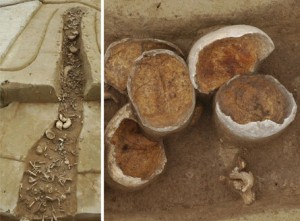 A large number of Neolithic bones found in a mass grave in what is now Herxheim, Germany, show signs of having been butchered and eaten over the course of several decades. It might have been part of a sacrificial ceremony or ritual reburial.
A large number of Neolithic bones found in a mass grave in what is now Herxheim, Germany, show signs of having been butchered and eaten over the course of several decades. It might have been part of a sacrificial ceremony or ritual reburial.
Artifacts found with the bones date to the Linear Pottery Culture, a western and central European culture from 7,500 to 7,000 years ago.
Damage typical of animal butchery appears on the bones, including that produced by a technique to separate the ribs from the spine, the scientists say. Heads were skinned and muscles removed from the brain case in order to remove the skullcap. Incisions and scrapes on jaws indicate that tongues were cut out.
Scrape marks inside the broken ends of limb bones indicate that marrow was removed.
People most likely made the chewing marks found near intentionally broken ends of hand and arm bones, Boulestin says.
Ongoing work at Herxheim has found signs of cannibalism on the bones of hundreds of other individuals, with only a few exceptions, he adds
The cannibalism is not confirmed, but it’s definitely the top hypothesis right now. It stands out. Before the Herxheim bones, only one previous find in France suggested Neolithic cannibalism, but it was on a far smaller scale. The remains of 6 people looked gnawed upon, not hundreds.
On the other hand, all the lower jaws and skull bases are missing, and that suggests reburial where specific bones were removed ritual purposes. The skin might have been removed and bodies dismembered as a part of the ritual without making a dinner of it.
University of Bordeaux anthropologist Bruno Boulestin thinks there was a major political crisis in European society 7,000 years ago, evidenced by mass murders at three central European sites around that time and abandoned settlements. Herxheim itself was abandoned, in fact.
Chemical analysis will show whether the victims were local or imports. You can tell from the elements in the bones what kind of food people grew up eating. If they were brought to the site, that would support both the cannibalism and the reburial hypotheses, so we not ever know for sure what exactly happened 7,000 years ago.